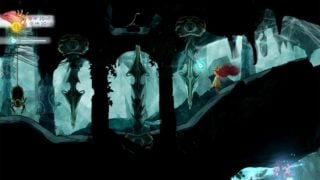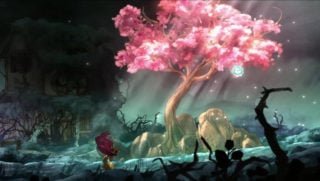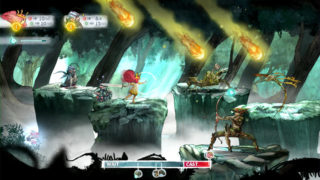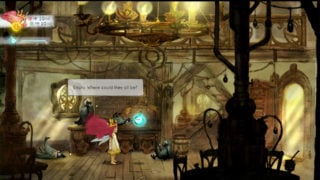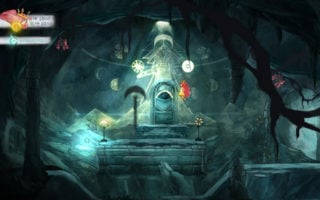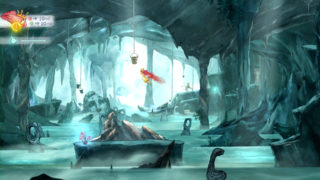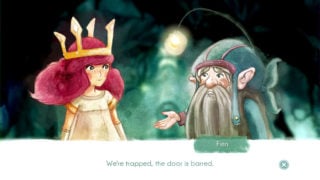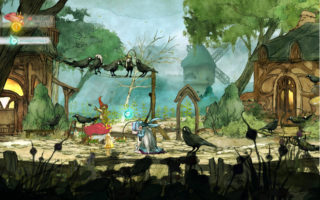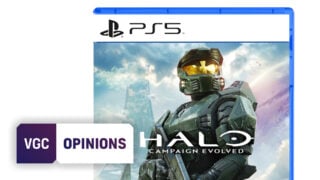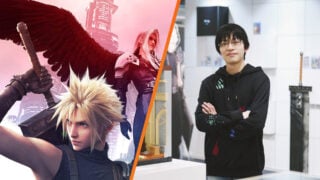Looking back on Ubisoft’s wild child
Creators candidly recall Ubisoft’s ‘indie game’ that defied convention

“I had people laughing at me in the corridor,” says Patrick Plourde, creative director on Ubisoft Montreal’s 2014 RPG Child of Light. “[They were saying] ‘oh, you’re making the little girl game’. But I didn’t care.”
As it turned out, Child of Light was a lot more than just a “little girl game”. After receiving praise from reviewers across the board it turned a profit within seven months, won in five categories at the Canadian Video Game Awards, and spurred Ubisoft to turn its developers into a new “core team” within the company. Last year, it was ported to Switch, which led to renewed calls from loyal fans for a sequel.

As Plourde tells VGC, we’re unlikely to get another Child of Light game anytime soon, even though he’s already outlined the story for a second prequel game. But for fans yearning to jump back into this magical universe, the original is still as enchanting as it was when it first came out exactly five years ago.
We spoke to Plourde, still at Ubisoft, and lead writer Jeffrey Yohalem, now at 2K, about the difficulties of writing purely in rhyme, how they avoided crunch despite tight deadlines, and why Child of Light changed their view of game development forever.
It all started when Plourde finished work on Far Cry 3—a process he calls “hellish” and “chaotic”—and had a month alone to decide what to do next. He wanted to collaborate with developers he admired on a game that wasn’t aggressive or violent, he tells us.
He wanted “another colour in the rainbow”, and he found it at the unlikely intersection of Final Fantasy 6 and the paintings of Edmund Dulac, an illustrator famous for his work on children’s books in the early 20th century.
“Those [Dulac] images are very evocative, they transport you to a fantasy world, and I was really excited about it,” he says. “And then there was a little video of the UbiArt Framework [game engine] that the team released with a bunch of different concepts. One of them was a [Final Fantasy artist] Yoshitaka Amano-esque guy with a big hat, and I’m like, ‘Ah, that game would be amazing’.”
The initial idea was to let players “play the concept art, play the paintings” that Plourde had discovered—and he soon built upon that by taking an online course in the theory and history of fairy tales. He became fascinated by their symbols and tropes, particularly how young girls and women were depicted as needing a “Prince Charming” to make their lives worthwhile. Plourde wanted to move beyond that to something far more modern that focused on “taking responsibility, helping others, being greater than ourselves”.
“It all started when Plourde finished work on Far Cry 3—a process he calls ‘hellish’ and ‘chaotic’—and had a month alone to decide what to do next. He wanted to collaborate with developers he admired on a game that wasn’t aggressive or violent”
Essentially the game would ask: “what is it to move past being a child?”—and he wanted to create his own symbols to carry the story forward. In the finished game protagonist Aurora, a young girl, initially has trouble carrying a sword and wears a crown that’s too big, but later grows into both when she accepts her responsibilities towards her friends and family.
To flesh out his ideas, Plourde recruited Yohalem as lead writer and gave him a folder of 400 paintings, a fake soundtrack composed of music that fit the mood he wanted, and a few story beats, such as the game starting with Aurora’s funeral. Yohalem tells us he wanted to impose his own challenges, too: most notably, he wanted Child of Light to be an epic poem, and that meant writing in rhyme.
“I had a notepad with me literally everywhere I went day and night, and I was writing stanzas,” he says. In Child of Light, you could also find notes that took the form of sonnets, and these were even harder to write because of their rigid structure, says Yohalem. “They took an incredible amount of time.”
Initially, the pair came up with a storybook outlining the general plot—which they used in their successful pitch to Ubisoft—and filled in the rest along the way. By keeping that structure flexible, Yohalem was able to build specific ideas, or clever passages of writing, into the story as he went along.
“When we created the storybook we had an idea of a giant, or a town with mice living in it, but when we got to making those things there were characters and quests that were created as we were designing,” he explains. “That was great, because as you’re writing the main stuff if you get ideas about other things, or a particular piece of writing that you want to attach to somebody, then a character is created out of that.”
Crunch time
The way the story was written also highlights two things that made Child of Light feel different to other Ubisoft projects: first, its development was relatively free of crunch despite tight deadlines for a small team, and second, that absolutely everybody on the project was obsessed with the game they were putting together.
Yohalem says writing Child of Light was “all-consuming… the hardest thing I’ve ever written”, but still says it was more relaxed than any other game he worked on at Ubisoft. “We definitely were way better rested,” says Yohalem. “We weren’t put through the ringer like on a AAA game.” The team were given rapid-fire deadlines, often weekly, but rather than cause stress, it kept them focused on their specific short-term goals, and helped them make quick progress.
“I loved it. It was creative, and not all about meetings. If it were up to me I’d be left alone with a couple of collaborators and we’d make the same process, but I think the rest of the studio has not seen the light yet.”
You’ll often hear developers say crunch is caused, in part, by poor forward planning, and it helped that Plourde was able to lay the groundwork before any other developers had even joined his team. He got the go-ahead from Ubisoft in September 2012, but the developers he wanted were tied up with other games until December, including Assassin’s Creed 3 and Far Cry 3. He had three months to work out details such as “what features we needed, the number of levels, the number of enemies”, which made it easier for incoming staff to plan their work.
The transition was made even easier by the passion of the incoming developers. Plourde only enlisted people that saw Child of Light as their “first choice”, he says. He wanted to create a sense of camaraderie, for the team to feel almost like “the outsiders” within Ubisoft, “and we’re all here to make something special together”.
He points to technical architect Jeff Preshing, who joined from the Rainbow Six development team, as an example. “He wanted out [of that team], and because he was on Rainbow Six for so many years, [not everybody] knew him at the company. Otherwise we wouldn’t ever have got him.”

Preshing was so happy to join that “he came in the weekend before his first day” to make a water simulation for Aurora’s hair, which made it look like it was flowing and floating. Plourde said he was amazed by the dedication and pleased with the results: he’d for a long time been “very jealous” of the way Disney’s animators had created Ariel from The Little Mermaid’s hair in 2D, and now he finally had something similar.
For the same reason, Plourde was happy to let Yohalem write the game as a poem, even though it wasn’t how he initially envisaged it. He could see how “fired up” Yohalem was about the idea. “It needs to be a passion project,” he says. “If we’re not passionate about it, why do it? We have other big projects that need a lot of people. It was about having people that this would be their first choice to make the game, and you sense that passion as a player.”
Recruiting a passionate team quickly created a “snowball effect” within Ubisoft, Plourde says—and internal attitudes began to change. Where there had been some “reticence” and ridicule towards the pint-sized role-playing game, now some of the company’s most talented developers wanted to join in.
“The vision was clear, and it created a snowball effect. I’d get people that were way too good, huge talent for a small game,” he says. “I was being laughed at four or five months before, and then…‘you need to stop because you’re endangering the studio’ [by pulling developers off other games]. If somebody doesn’t want to go on Assassin’s Creed, it’s not my problem,” he says.
A matter of timing
Both Plourde and Yohalem say the process changed them as developers. Yohalem enjoyed working on a shorter, more focussed game, and he’s now convinced that taking risks is essential to creating an interesting experience. “What excites you initially and causes you to invest and make something beautiful is what’s going to make it good, not tonnes of careful decisions,” he says.
Plourde says Child of Light confirmed that he should only work on projects he’s passionate about. It turned him into an “adventurer” or sorts: he was able to explore and research a set of subjects that he initially knew nothing about, get fascinated by them, and create a game out of it.

“I loved it. It was creative, and not all about meetings. If it were up to me I’d be left alone with a couple of collaborators and we’d make the same process, but I think the rest of the studio has not seen the light yet.”
As Plourde hints at, the impact on Ubisoft Montreal appears to have been more short-lived. The company has changed since agreeing to make Child of Light, Plourde says, and now sees itself as more “adult”, less “adolescent”. And like most other AAA developers, it’s increasingly focused on “games-as-a-service games”, he says. “I don’t think it’s the type of game that Ubisoft wants to make [anymore].”
But that just makes it even more remarkable that Child of Light exists in the first place. It feels like it happened just at the right time, with just the right team. We may not see something else like it from Ubisoft for a long time, but it remains a testament to what a small, passionate team of developers can produce when they’re willing to go against the grain.
